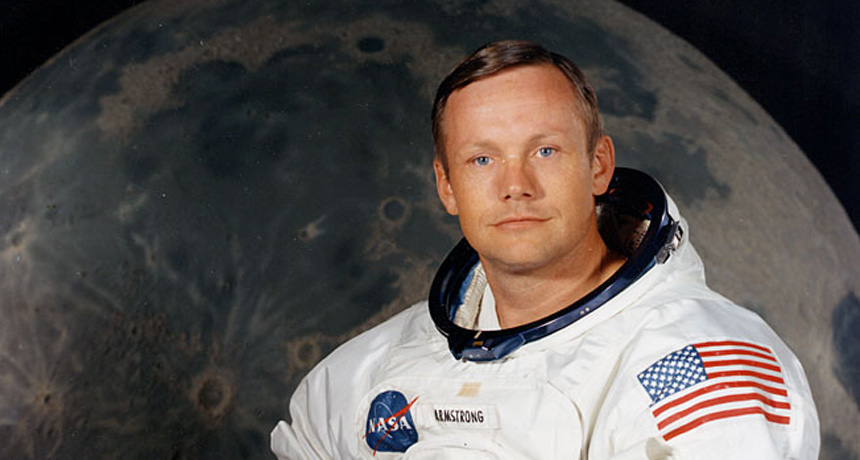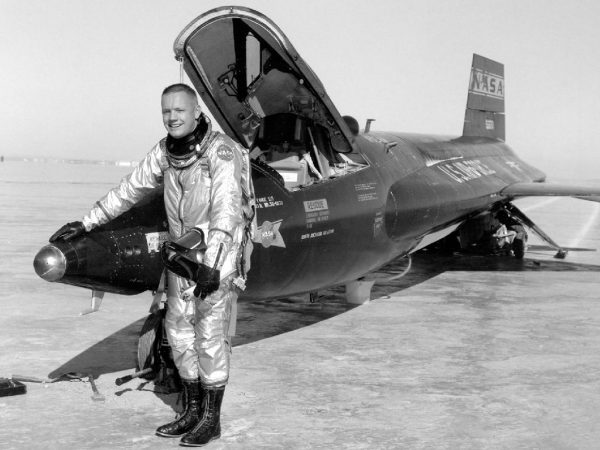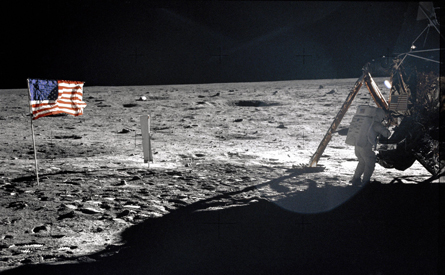The first moon walker
Neil Armstrong made history in 1969 when he planted his feet — and a flag — on the moon

Astronaut Neil Armstrong’s official portrait for the Apollo 11 mission to the moon.
NASA
By Janet Raloff
Editor’s note: July 20, 2014 marks the 45th anniversary of the first moon walk.
A little more than 40 years ago, an American astronaut climbed down the ladder of his lunar landing module — the Eagle — and became the first human to touch the moon’s surface. As he steadied himself, he said: “That’s one small step for a man, one giant leap for mankind.” Around the globe, an estimated 530 million people watched on their televisions as Neil Armstrong uttered those now-famous words. On August 25, this American hero died at age 82.
Armstrong and fellow moon walker Edwin “Buzz” Aldrin briefly became the first ambassadors to another world on July 20, 1969. Setting foot on another celestial body was a massive and breathtaking achievement. And Armstrong’s words brought the human scale of that accomplishment to households around the world.
“Neil was among the greatest of American heroes — not just of his time, but of all time,” said President Barack Obama. “When [Armstrong] and his fellow crew members lifted off aboard Apollo 11 in 1969, they carried with them the aspirations of an entire nation.” These men showed the world “that with enough drive and ingenuity, anything is possible,” the president added. And these brave individuals “delivered a moment of human achievement that will never be forgotten.”
Preparing for a life of exploration
Armstrong fell in love with flying at a young age. By 15 he was already taking lessons. He picked up odd jobs around his hometown to pay for flight time in a small airplane. He got his student’s flying permit, at 16, before he got his driver’s license.
In college, he trained as an aeronautical and aerospace engineer. In this field, people learn how to design and control not only aircraft but also jets and other propulsion systems.
But before he could finish college, Armstrong was called up for military service. He signed on to become a Navy fighter pilot. He flew 78 combat missions in Korea. During one, his plane was hit and he had to parachute out. It was an event that could have killed him. But it didn’t frighten him off of flying. Instead, he went back to school and finished his studies. Then he joined a federal agency that would become the National Aeronautics and Space Administration, or NASA.

There, for 17 years, Neil Armstrong held a number of different jobs. He started as a test pilot for many pioneering aircraft. These included the X-15, an experimental vehicle that could zoom through the atmosphere at more than 4,000 miles per hour! He made seven flights on that space plane, at one point reaching an altitude of 63,198 meters (207,500 feet). That’s about six times higher than today’s standard jumbo jets. And he didn’t just pilot the X-15. He also worked closely with the aircraft’s engineers and designers to improve the plane’s flight controls. In all, Armstrong flew more than 200 different models of aircraft, including jets, helicopters and gliders.
That all changed in 1962 when Armstrong joined NASA’s astronaut corps. Suddenly, his focus became rocketry and space exploration. Within four years, he was given the command of the Gemini 8 spacecraft, from which he controlled the first successful docking, or linkup, of two vehicles in space.
But the highlight of his career was Apollo 11, that famous mission to the moon. And almost 1 in 5 people alive at the time shared in the excitement, watching as blurry television images showed Armstrong descending to the lunar surface.
His team’s landing module had set down in a region known as the Sea of Tranquility. Within 20 minutes, Aldrin joined him. There, the two took photos, collected moon rocks and set up some science experiments.
They also left mementos for future space travelers. These included a patch carrying the names of Virgil Grissom, Edward White and Roger Chaffee — Apollo 1 crew members who died in a launchpad fire. Armstrong and Aldrin also left medals inscribed with the names of Vladimir Komarov and Yuri Gagarin, two Russian astronauts (called cosmonauts) who died during space flights in 1967 and 1968. Finally, they left a small silicon disc that carried a miniature goodwill message from 73 world leaders (its message is so small that you would need a microscope to see the words).
Neil Armstrong walking on the moon for the first time.
Aldrin returned to the Eagle after 93 minutes on the moon’s surface. Armstrong, the mission’s commander, stayed 40 minutes longer. He savored the last bits of this huge adventure. Then the pair rejoined Michael Collins aboard the Apollo 11 space capsule for their return trip home. In all, the team spent more than eight days in space and traveled 953,054 miles (more than 1.5 million kilometers).

Aldrin/NASA
After his Apollo 11 trip to the moon, Armstrong stayed on at NASA and eventually rose to become its deputy associate administrator, in Washington, D.C. Later, he became a college professor, teaching aerospace engineering. He then worked for several aerospace companies. It seems the man never could get enough of the idea of cruising through — and occasionally outside of — Earth’s atmosphere.
After his death, Armstrong’s family issued a statement. They said, in part: “While we mourn the loss of a very good man, we also celebrate his remarkable life and hope that it serves as an example to young people around the world to work hard to make their dreams come true, to be willing to explore and push the limits, and to selflessly serve a cause greater than themselves.”
Observes NASA Administrator Charles Bolden: “As long as there are history books, Neil Armstrong will be included in them, remembered for taking humankind’s first small step on a world beyond our own.”
As a mark of respect for Armstrong and what his achievements represented, President Obama ordered that flags throughout the country and at U.S. embassies abroad be lowered to half-staff on the day Armstrong is buried.
Power Words
aerospace A research field devoted to the study of Earth’s atmosphere and the space beyond or to aircraft that travel in the atmosphere and space.
astronautics A research field specializing in the design and construction of aircraft — including those created for space travel.
Apollo missions NASA’s third human spaceflight program. It sought to develop the technologies needed for long-distance space travel. It got a big kick-start after President John F. Kennedy proposed in 1961 creating the national goal of “landing a man on the Moon and returning him safely to the Earth.”
astronaut People trained to travel into space for research and exploration.
celestial body Any naturally formed objects of substantial size in space. Examples include comets, asteroids, planets, moons, stars and galaxies.
cosmonaut Russian term for astronaut.
docking The act of bringing together and inserting one thing into another.
engineer An individual who applies science to practical purposes, such as the design or development of machines, structures or systems.
lander A special, small vehicle designed to ferry humans between a spacecraft and the celestial body they will explore.
lunar Relating to Earth’s moon.
propulsion The act or process of driving something forward, using a force. For instance, jet engines are one type of propulsion for keeping airplanes aloft.







